check engine SSANGYONG KORANDO 2013 Workshop Manual
[x] Cancel search | Manufacturer: SSANGYONG, Model Year: 2013, Model line: KORANDO, Model: SSANGYONG KORANDO 2013Pages: 1336, PDF Size: 92.18 MB
Page 601 of 1336

0000-00
Measuring the voltage drop between lines
Measure the voltage drop between alternator B+ and battery B+. -
Specified valuebelow 0.3V
If the value is out of the specified value, check the terminal and clamp for looseness.
Checking the charge warning lamp
Check if the charge warning lamp goes out.
If the charge warning lamp does not go off, inspect the electric circuit.
Start the engine and check if the charge warning lamp keeps off. 1.
2.
-
3.
Page 612 of 1336

Operation of charge warning lamp
ECU checks the generating voltage from alternator and circuit conditions and sends the warning lamp ON
signal to meter cluster through CAN line.Basic control logic according to the driving conditions
Engine ECU determines the engine loads according to the fuel injection volume and engine speed. It
charges the battery by increasing the generating voltage during deceleration. To improve the fuel
economy by reducing the alternator load during acceleration, engine ECU decreases the generating
voltage and consumes the battery voltage.
Page 631 of 1336
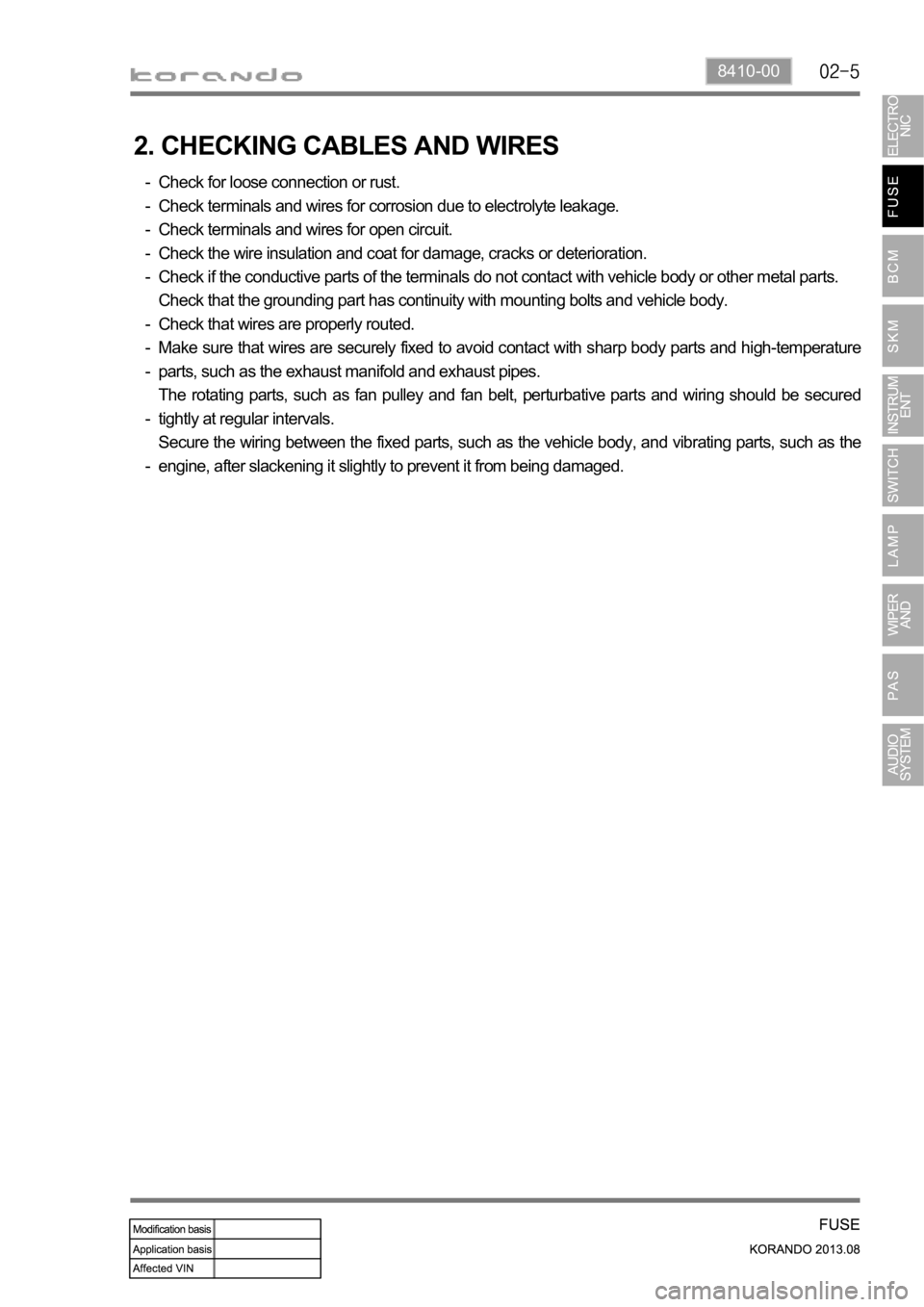
8410-00
2. CHECKING CABLES AND WIRES
Check for loose connection or rust.
Check terminals and wires for corrosion due to electrolyte leakage.
Check terminals and wires for open circuit.
Check the wire insulation and coat for damage, cracks or deterioration.
Check if the conductive parts of the terminals do not contact with vehicle body or other metal parts.
Check that the grounding part has continuity with mounting bolts and vehicle body.
Check that wires are properly routed.
Make sure that wires are securely fixed to avoid contact with sharp body parts and high-temperature
parts, such as the exhaust manifold and exhaust pipes.
The rotating parts, such as fan pulley and fan belt, perturbative parts and wiring should be secured
tightly at regular intervals.
Secure the wiring between the fixed parts, such as the vehicle body, and vibrating parts, such as the
engine, after slackening it slightly to prevent it from being damaged. -
-
-
-
-
-
-
-
-
-
Page 671 of 1336
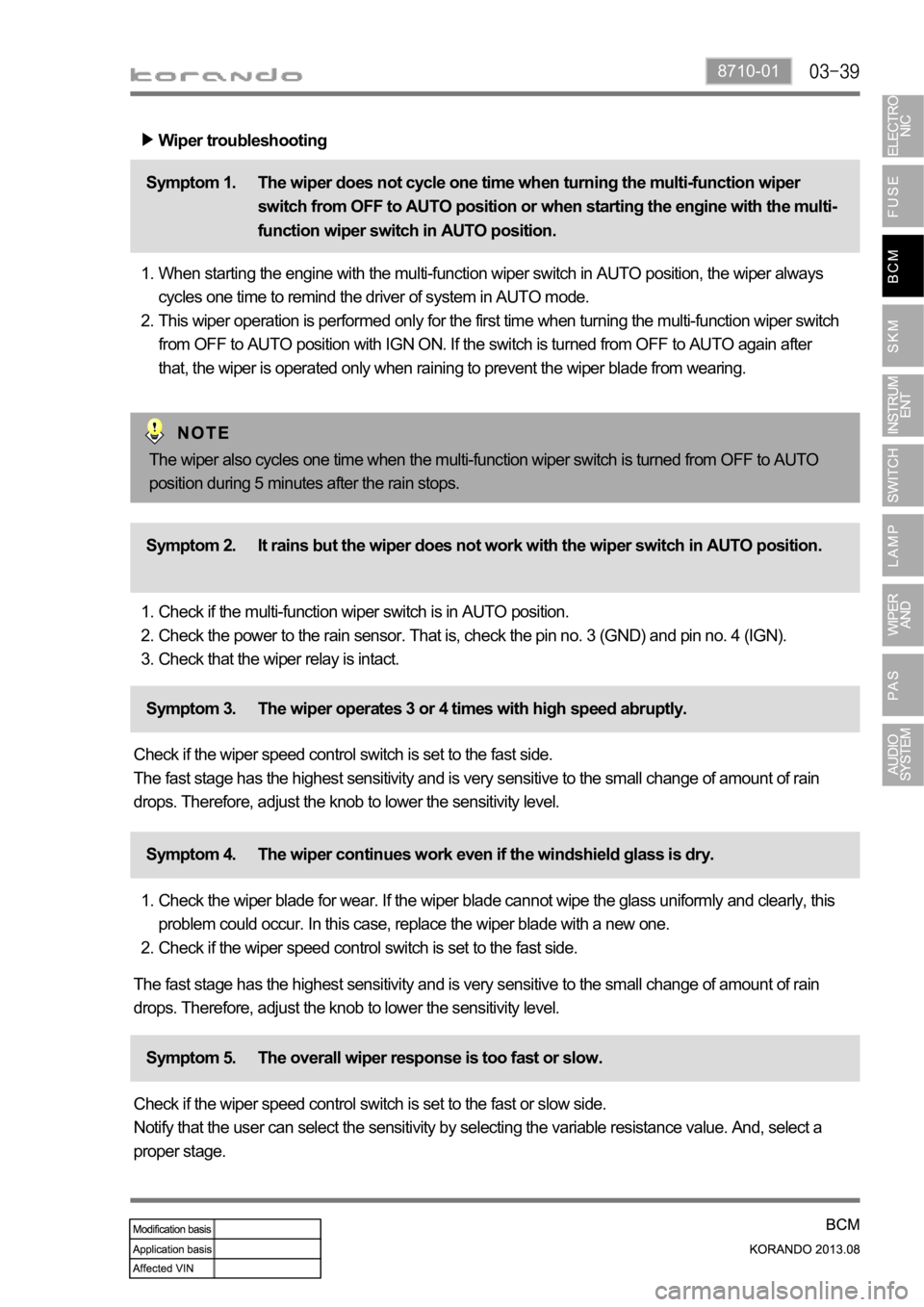
8710-01
Wiper troubleshooting
The wiper does not cycle one time when turning the multi-function wiper
switch from OFF to AUTO position or when starting the engine with the multi-
function wiper switch in AUTO position. Symptom 1.
When starting the engine with the multi-function wiper switch in AUTO position, the wiper always
cycles one time to remind the driver of system in AUTO mode.
This wiper operation is performed only for the first time when turning the multi-function wiper switch
from OFF to AUTO position with IGN ON. If the switch is turned from OFF to AUTO again after
that, the wiper is operated only when raining to prevent the wiper blade from wearing. 1.
2.
It rains but the wiper does not work with the wiper switch in AUTO position. Symptom 2.
Check if the multi-function wiper switch is in AUTO position.
Check the power to the rain sensor. That is, check the pin no. 3 (GND) and pin no. 4 (IGN).
Check that the wiper relay is intact. 1.
2.
3.
The wiper operates 3 or 4 times with high speed abruptly. Symptom 3.
Check if the wiper speed control switch is set to the fast side.
The fast stage has the highest sensitivity and is very sensitive to the small change of amount of rain
drops. Therefore, adjust the knob to lower the sensitivity level.
The wiper continues work even if the windshield glass is dry. Symptom 4.
Check the wiper blade for wear. If the wiper blade cannot wipe the glass uniformly and clearly, this
problem could occur. In this case, replace the wiper blade with a new one.
Check if the wiper speed control switch is set to the fast side. 1.
2.
The fast stage has the highest sensitivity and is very sensitive to the small change of amount of rain
drops. Therefore, adjust the knob to lower the sensitivity level.
The overall wiper response is too fast or slow. Symptom 5.
Check if the wiper speed control switch is set to the fast or slow side.
Notify that the user can select the sensitivity by selecting the variable resistance value. And, select a
proper stage.The wiper also cycles one time when the multi-function wiper switch is turned from OFF to AUTO
position during 5 minutes after the rain stops.
Page 751 of 1336

8710-01
24. IMMOBILIZER SYSTEM
1) System Description
The BCM without SKM communicates with the transponder in the REKES key and immobilizer unit in
the key box through wireless communication. The immobilizer unit and BCM check the encrypted codes
received through hard wire communication to start the engine.
Stays on: Communication failure between immobilizer and EMS (ECU)
Flashes: Immobilizer coding failure (once per second)
2) System Diagram
Page 758 of 1336
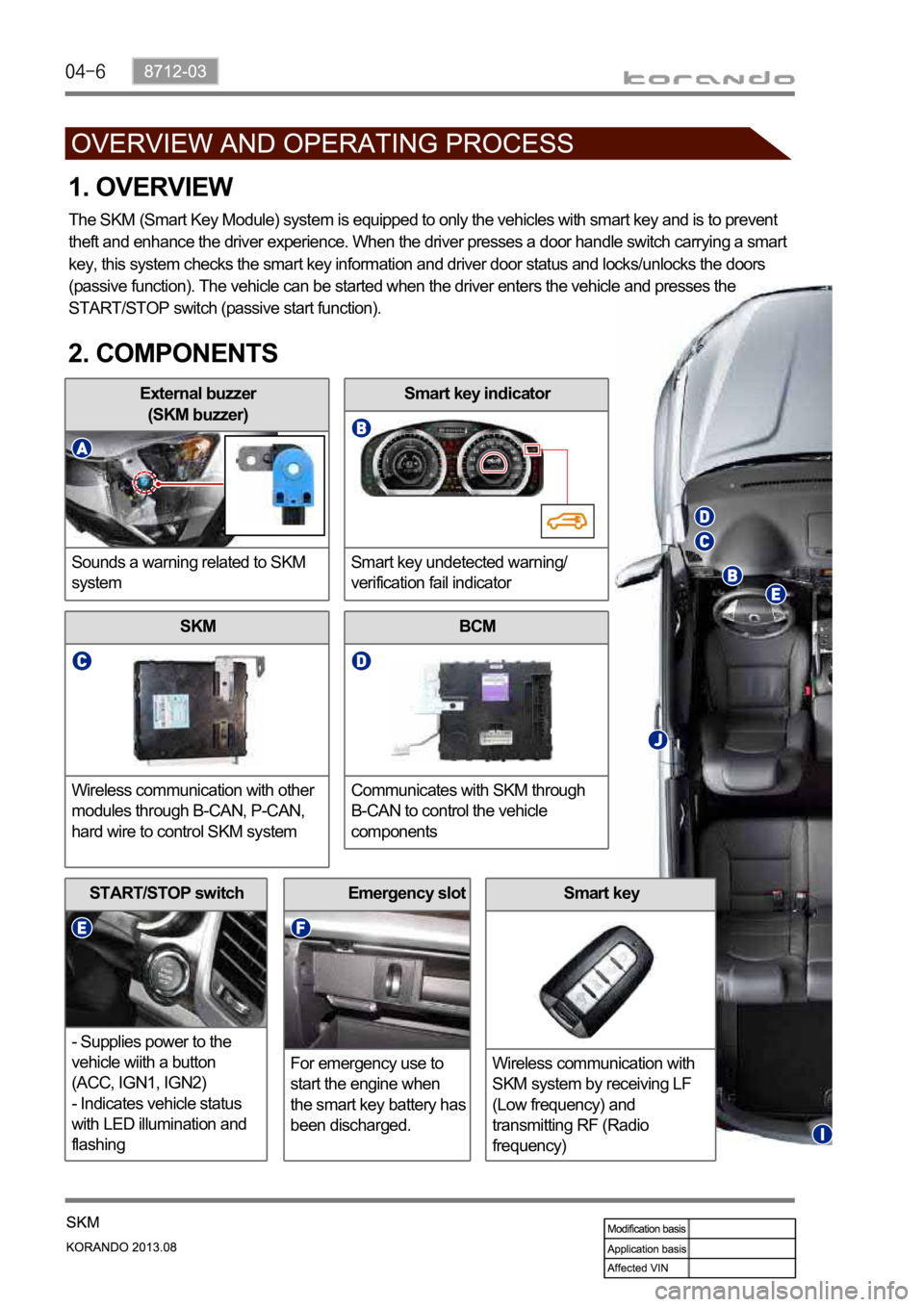
Smart key
Wireless communication with
SKM system by receiving LF
(Low frequency) and
transmitting RF (Radio
frequency)Emergency slot
For emergency use to
start the engine when
the smart key battery has
been discharged.
SKM
Wireless communication with other
modules through B-CAN, P-CAN,
hard wire to control SKM system
External buzzer
(SKM buzzer)
Sounds a warning related to SKM
system
START/STOP switch
- Supplies power to the
vehicle wiith a button
(ACC, IGN1, IGN2)
- Indicates vehicle status
with LED illumination and
flashing
1. OVERVIEW
The SKM (Smart Key Module) system is equipped to only the vehicles with smart key and is to prevent
theft and enhance the driver experience. When the driver presses a door handle switch carrying a smart
key, this system checks the smart key information and driver door status and locks/unlocks the doors
(passive function). The vehicle can be started when the driver enters the vehicle and presses the
START/STOP switch (passive start function).
2. COMPONENTS
Smart key indicator
Smart key undetected warning/
verification fail indicator
BCM
Communicates with SKM through
B-CAN to control the vehicle
components
Page 774 of 1336
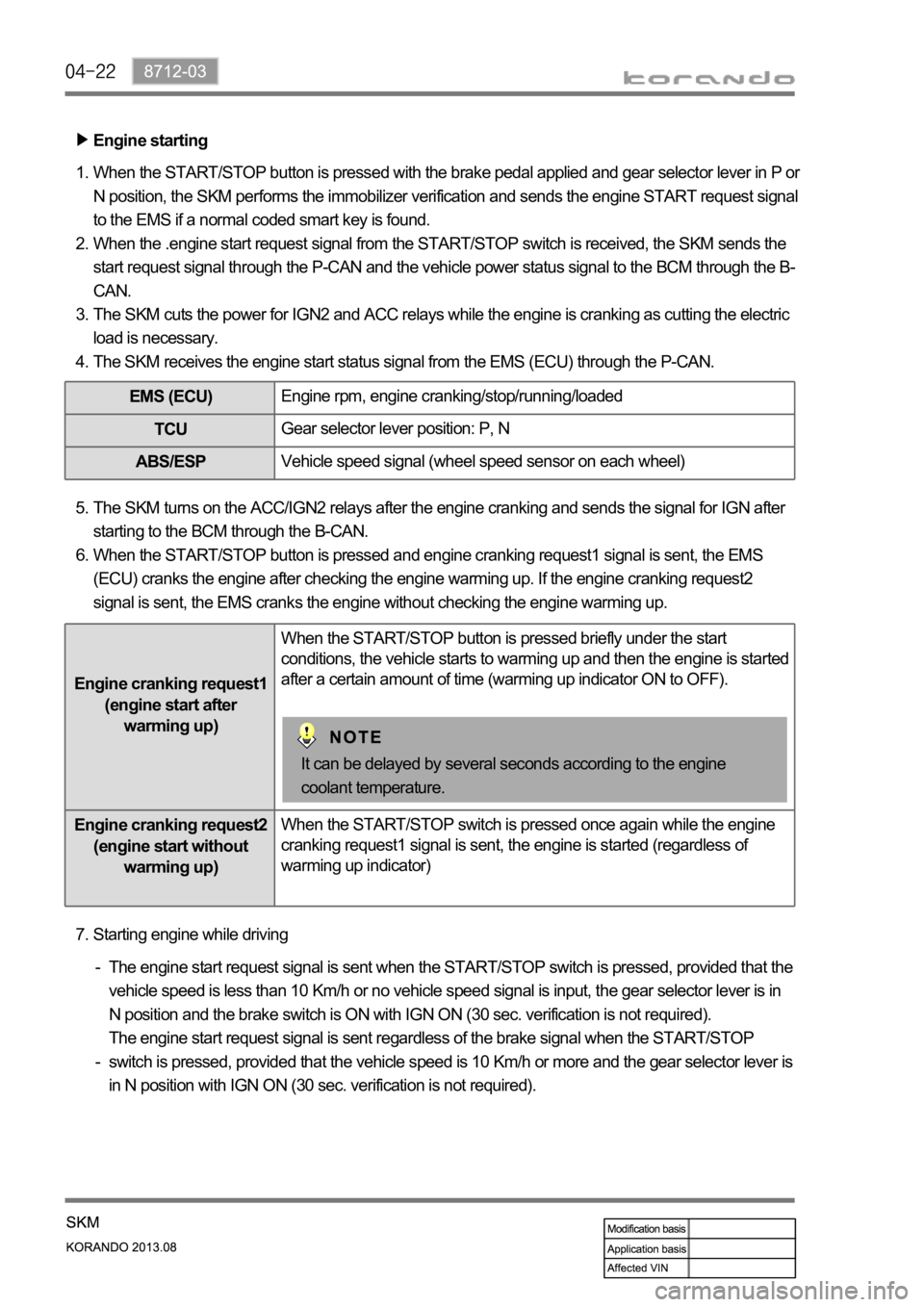
Engine starting
When the START/STOP button is pressed with the brake pedal applied and gear selector lever in P or
N position, the SKM performs the immobilizer verification and sends the engine START request signal
to the EMS if a normal coded smart key is found.
When the .engine start request signal from the START/STOP switch is received, the SKM sends the
start request signal through the P-CAN and the vehicle power status signal to the BCM through the B-
CAN.
The SKM cuts the power for IGN2 and ACC relays while the engine is cranking as cutting the electric
load is necessary.
The SKM receives the engine start status signal from the EMS (ECU) through the P-CAN. 1.
2.
3.
4.
EMS (ECU)Engine rpm, engine cranking/stop/running/loaded
TCUGear selector lever position: P, N
ABS/ESPVehicle speed signal (wheel speed sensor on each wheel)
The SKM turns on the ACC/IGN2 relays after the engine cranking and sends the signal for IGN after
starting to the BCM through the B-CAN.
When the START/STOP button is pressed and engine cranking request1 signal is sent, the EMS
(ECU) cranks the engine after checking the engine warming up. If the engine cranking request2
signal is sent, the EMS cranks the engine without checking the engine warming up. 5.
6.
Engine cranking request1
(engine start after
warming up)When the START/STOP button is pressed briefly under the start
conditions, the vehicle starts to warming up and then the engine is started
after a certain amount of time (warming up indicator ON to OFF).
Engine cranking request2
(engine start without
warming up)When the START/STOP switch is pressed once again while the engine
cranking request1 signal is sent, the engine is started (regardless of
warming up indicator)
It can be delayed by several seconds according to the engine
coolant temperature.
Starting engine while driving 7.
The engine start request signal is sent when the START/STOP switch is pressed, provided that the
vehicle speed is less than 10 Km/h or no vehicle speed signal is input, the gear selector lever is in
N position and the brake switch is ON with IGN ON (30 sec. verification is not required).
The engine start request signal is sent regardless of the brake signal when the START/STOP
switch is pressed, provided that the vehicle speed is 10 Km/h or more and the gear selector lever is
in N position with IGN ON (30 sec. verification is not required). -
-
Page 799 of 1336

8010-01
Indicator
(amber)
ESP
ESP OFF indicator
Engine check warning lamp
Indicator
(amber)
Indicator
(amber)
Indicator (red)
Battery charge warning lamp
Indicator (red)
Engine oil level warning lamp
This lamp comes on if any sensor or device related to the engine control is
defective.
This lamp comes on when the start switch is ON or when the battery level is
low.
(For EEM, warning lamp is controlled according to CAN signal)
This lamp comes on when the ignition switch is turned to "ON" position,
and then goes off if the engine oil level is normal.
If the engine oil level warning lamp comes on while driving, check the
engine oil level and oil leakage. -
- This indicator comes on when the ESP system is faulty.
This indicator comes on when pressing the ESP OFF switch.
Page 832 of 1336
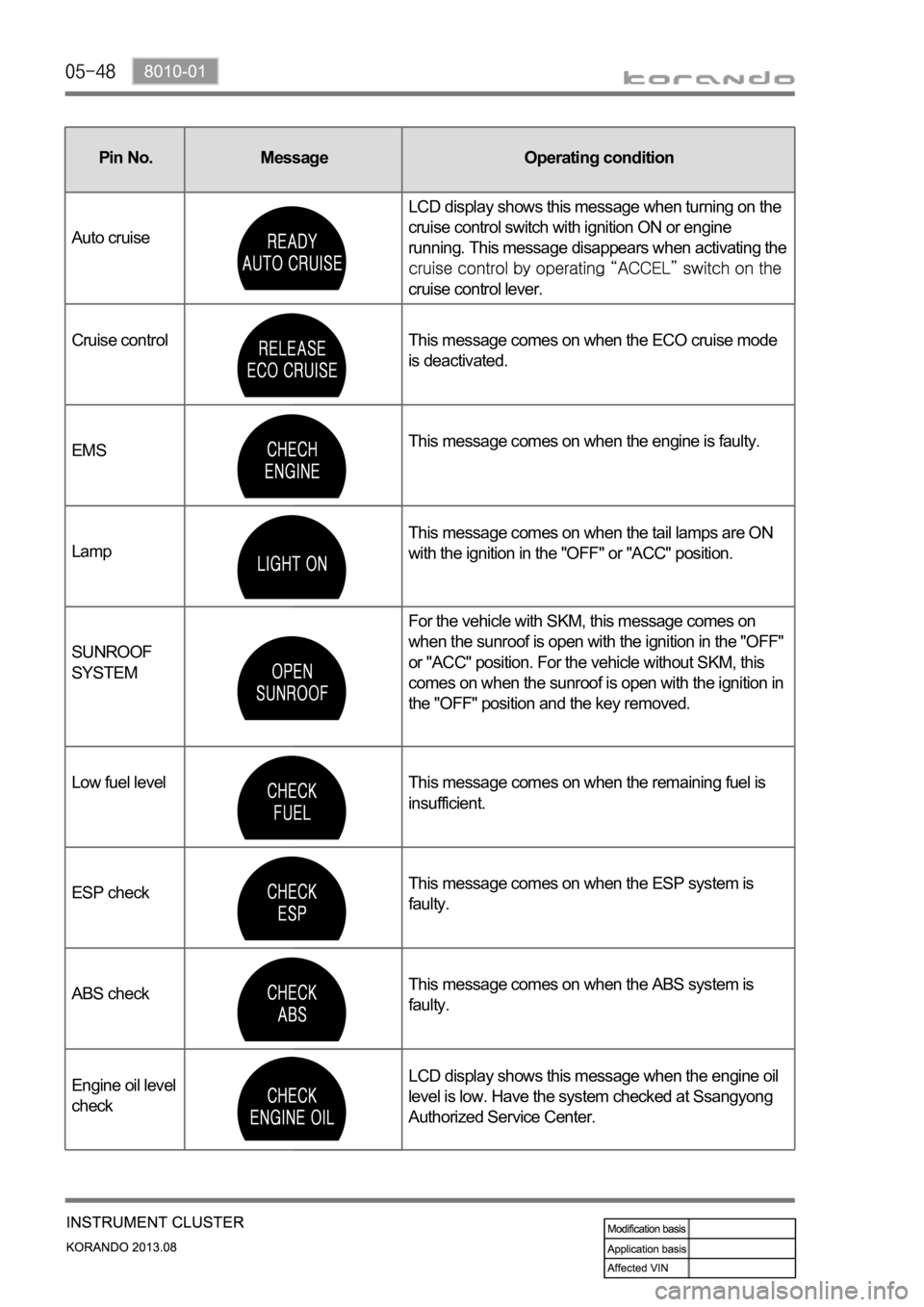
Pin No.Message
Operating condition
Domestic Export
Cruise control This message comes on when the ECO cruise mode
is deactivated.
EMSThis message comes on when the engine is faulty.
LampThis message comes on when the tail lamps are ON
with the ignition in the "OFF" or "ACC" position.
SUNROOF
SYSTEMFor the vehicle with SKM, this message comes on
when the sunroof is open with the ignition in the "OFF"
or "ACC" position. For the vehicle without SKM, this
comes on when the sunroof is open with the ignition in
the "OFF" position and the key removed.
Low fuel level This message comes on when the remaining fuel is
insufficient.
ESP checkThis message comes on when the ESP system is
faulty.
ABS check This message comes on when the ABS system is
faulty.
Engine oil level
checkLCD display shows this message when the engine oil
level is low. Have the system checked at Ssangyong
Authorized Service Center.Pin No. Message Operating condition
Auto cruiseLCD display shows this message when turning on the
cruise control switch with ignition ON or engine
running. This message disappears when activating the
cruise control lever.
Page 927 of 1336
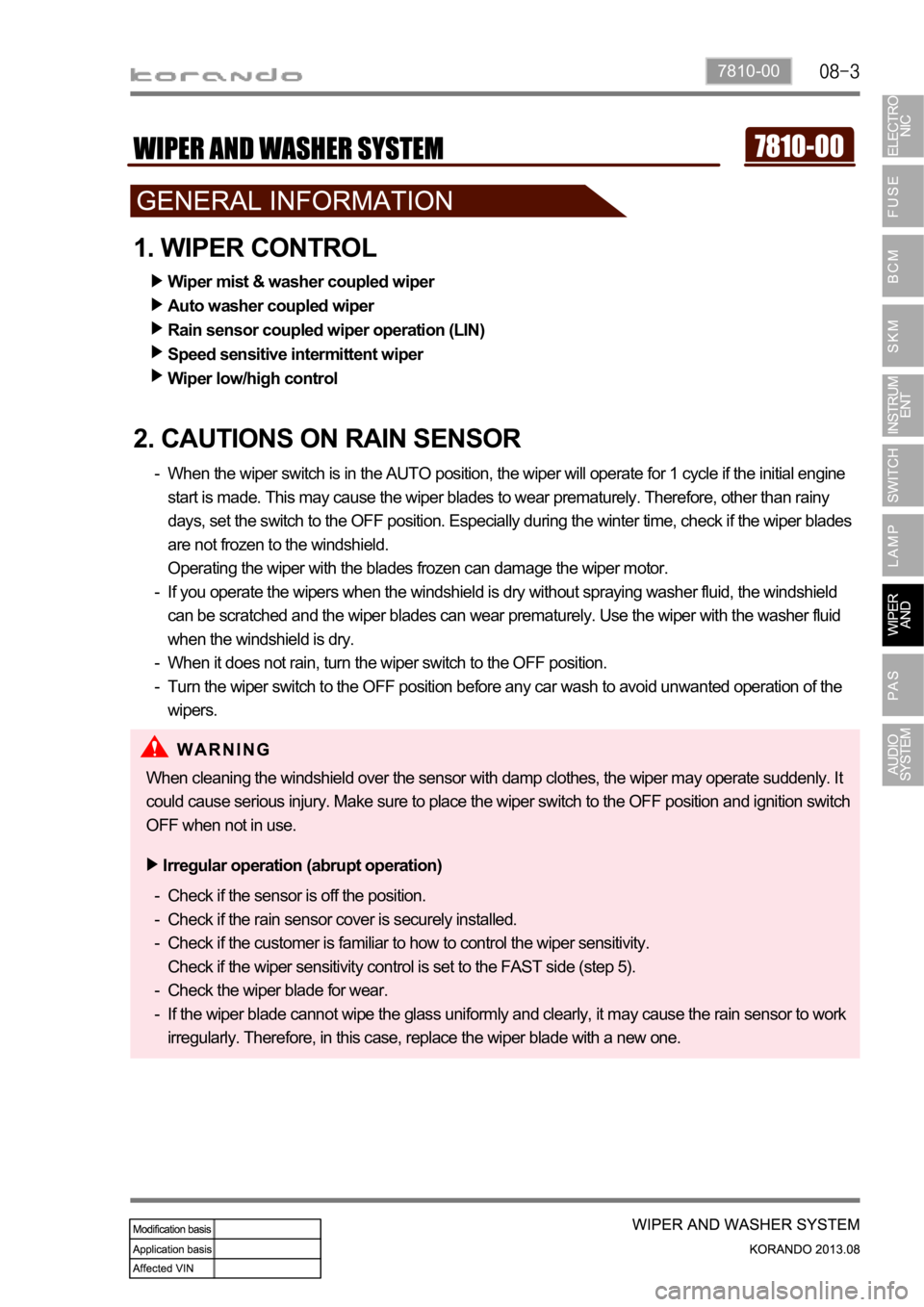
7810-00
1. WIPER CONTROL
2. CAUTIONS ON RAIN SENSOR
When the wiper switch is in the AUTO position, the wiper will operate for 1 cycle if the initial engine
start is made. This may cause the wiper blades to wear prematurely. Therefore, other than rainy
days, set the switch to the OFF position. Especially during the winter time, check if the wiper blades
are not frozen to the windshield.
Operating the wiper with the blades frozen can damage the wiper motor.
If you operate the wipers when the windshield is dry without spraying washer fluid, the windshield
can be scratched and the wiper blades can wear prematurely. Use the wiper with the washer fluid
when the windshield is dry.
When it does not rain, turn the wiper switch to the OFF position.
Turn the wiper switch to the OFF position before any car wash to avoid unwanted operation of the
wipers. -
-
-
-Wiper mist & washer coupled wiper
Auto washer coupled wiper
Rain sensor coupled wiper operation (LIN)
Speed sensitive intermittent wiper
Wiper low/high control
Check if the sensor is off the position.
Check if the rain sensor cover is securely installed.
Check if the customer is familiar to how to control the wiper sensitivity.
Check if the wiper sensitivity control is set to the FAST side (step 5).
Check the wiper blade for wear.
If the wiper blade cannot wipe the glass uniformly and clearly, it may cause the rain sensor to work
irregularly. Therefore, in this case, replace the wiper blade with a new one. -
-
-
-
-Irregular operation (abrupt operation)
When cleaning the windshield over the sensor with damp clothes, the wiper may operate suddenly. It
could cause serious injury. Make sure to place the wiper switch to the OFF position and ignition switch
OFF when not in use.